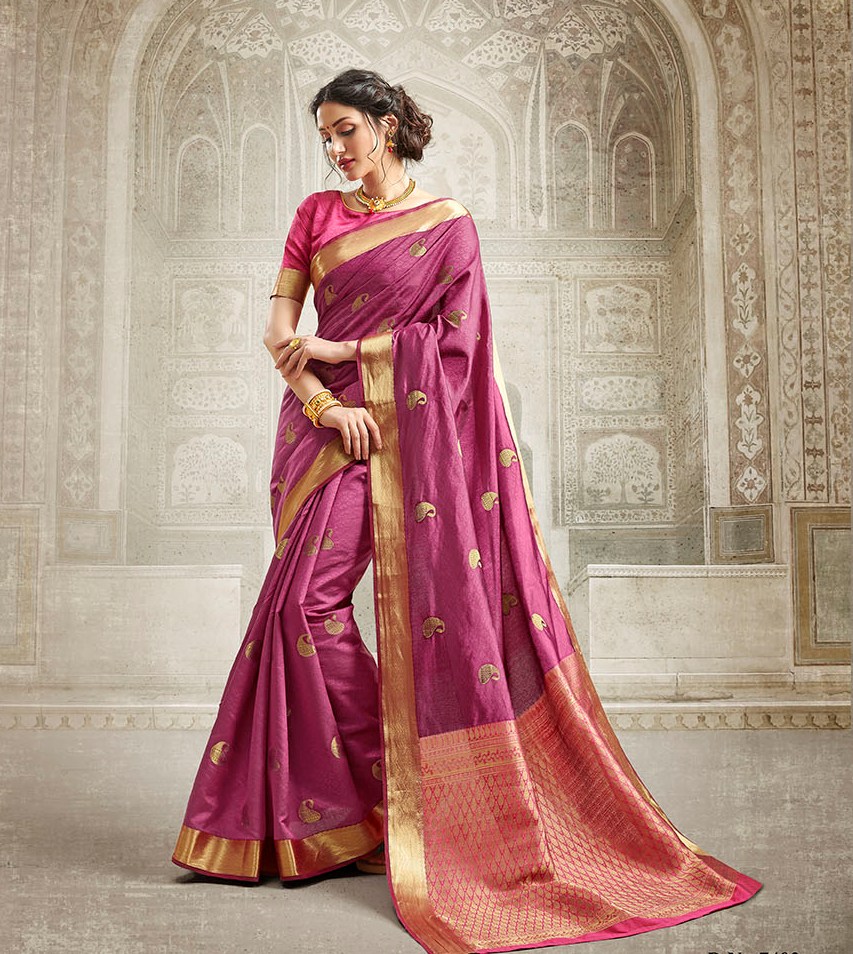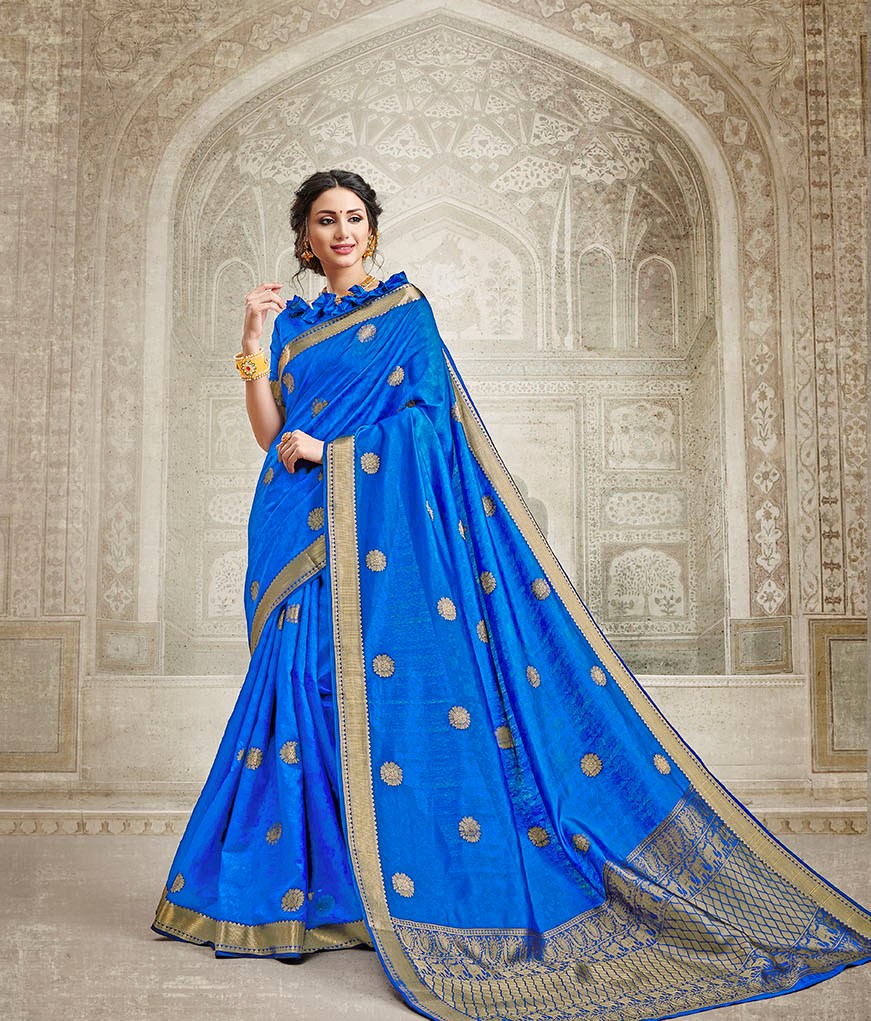A small village in Andhra Pradesh, Mangalagiri is known for its eponymous handlooms and the craft continues to thrive despite several odds.
Located between the cities of Vijayawada and Guntur is the tiny hamlet of Mangalagiri that is known for its fine cotton textiles. Almost every home here is involved with something to do with the fabric. It is common to see yarns being woven into threads as well as weaving centers where the workers are at the hand looms busy at work. They sound of the weaving in these wooden looms is typical as the weavers sit on the ground level with their feet firmly on the ground so that the weaves are tight and the fabric has a firm texture.
Traditional Textiles
If there is one thing that’s magnificent about traditional Indian textiles, it is the unparalleled attention to delivering the highest, handcrafted quality possible. The soft and fine weaves of Mangalagiri cottons is one example of this pristine quality. These fabrics give base to the resurgence in handlooms and the way designers are now moving back to these weaves to offer the best from this country. Puneet Jain, Director ODHNI says, “the Mangalagiri weave is a fine cotton fabric which is handcrafted in the weaving town of Mangalagiri in Guntur, Andhra Pradesh. Here, 5000 weavers work for wholesalers and 50 other local outlets – in order to make the pure cotton yarn. The distinct fine yarn (with a thread count of 80×80 threads) is tightly woven over pit looms to get a distinct, soft texture. One, so soft that it is intentionally kept plain, with a thick Zari border superimposed as another weave on top. The base cotton is boiled to removed impurities, dried and then woven into the fabric. This is then dyed in vats and prepared for the Zari weave.” What makes the fabric distinct is the lack of embroidery or heavy designs on the Mangalagiri weave. It is intentionally left plain or woven into simple checks. The thick gold or silver zari border, tribal motifs on the pallu and the inverted check patterns make it easy to identify this weave over others. The fabric is then sold either as finished sarees or fabric cuts for salwar suits and other dressing material. The delicate Zari border in gold over extra-fine cotton makes Mangalagiri fabric extremely exquisite and enchanting.
Technique Tales
The weavers in Mangalagiri work on the pit loom and the sound of the loom’s movement is unmissable in the village here. There are over 10 looms in each of the weaving centers that are scattered across the village where you can see the villagers busy at work. The combed yarns that are readied in the small alleys that surround the weaving centers are woven using a warp and weft interlacing technique to create these weaves. The saris are usually always in pure cotton yarn largely sourced from neighbouring Guntur and have with zari work and are coloured using natural and synthetic dyes. The yarn is washed and dipped in boiling water that also has the colour and the yarns are mixed in slowly for an even tone and then dried in the shade. The saris are typically plain and the only adornment is of the zari which is the typical design. However there are some stores that retail saris with a thread border as well but these kind of saris are fewer in number. The body of the saris is typically plain with occasional stripes or checks patterns. The saris are great for all seasons as they are light in the summer months and are warm in the winter months. The recent interest in traditional saris has spiked demand for these saris which has also ensured the villagers who work on the looms have a steady source of income. The community that works on these weaves belong to the Padmashali community who are weavers by tradition.

Revival Cues
The Mangalagiri fabric is such a human intensive operation, that its very existence depends on more and more weavers taking up the handcrafted textile. This, unfortunately, is not the case as few weavers actually receive their due, especially when you look at the sheer effort involved in creating the textile. “Fewer weavers take to the form, resorting to odd jobs or even quitting the profession altogether. This is also where patronage from the government and design houses comes into play. While the Mangalagiri weave has been labelled a handicraft from Andhra Pradesh, many designers have taken to supporting traditional Indian textiles and artisans to help fuel these traditions. While A-listers like Sabyasachi, Anita Dongre and Gaurang Shah have been using traditional Indian weaves as base for their latest collections,” says Yatin Jain, Director ODHNI. Many e-commerce platforms also offer new wings to traditional textiles, by offering these handloom weaves at affordable cost. They also help in offering Indie-made garments from these weaves, giving urban buyers a chance to dress Indian, yet modern. “Using the Mangalagiri and other traditional textiles as a base, more brands can decidedly go Indie in their approach, the way Anita Dongre does, for example, with her Grassrootlabel. Apart from using the soft cotton yarn to craft scarves, stoles and dupattas, the fabric can be moulded into loose tops, tunics, wrap dresses and other summery delights. The all-season fabric can also be seamlessly used culottes, trousers and wide-open leg palazzo pants,” adds Puneet. Many Indian fashion designers of international fame are promoting Mangalagiri through their creations that reminisce the designs and culture of the 16th century. “Besides, the government is also taking some bold initiatives to preserve this handloom art. Various Bollywood celebrities are also endorsing this south Indian fabric which is not just light but graceful, too,” avers Nidhi Yadav, Creative Head and Founder AKS Clothings. Apart from saris, the weavers now also have salwar kameez, yardage, stoles and dupattas to make the fabric attractive to the younger generation. Another attractive factor about Mangalagiri fabrics is the sheer array of colours that it is available in which makes it a popular choice.
Challenges Galore
The fabric has also received the Geographical Indication (GI) certificate in 2013, courtesy the efforts of Mangalagiri Master Weavers’ Association (MMWA) whose master weavers and cooperative societies worked tirelessly for the same. There are not more than 5000 skilled weavers in India who have expertise in Mangalagiri fabric. “Working on traditional looms is a tedious process, and even after dedicating two full days for weaving a sari, the weaver collects not more than Rs. 400. So, the young generation is not very much interested in carrying forward the 500-year-old legacy of their forefathers. Hence, government support is mandatory to conserve this endangered profession,” says Yadav. It is also the long gestation period that goes into each sari taking 1.5 to 2 days that makes the weaves unattractive for the younger generation who neither have the patience nor the perseverance to work on the hand looms. Mangalagiri has fortunately caught the fancy of several big designers who are now doing their bit for the cause of the fabric by popularizing it using the same in their designs. What this has done is that it has popularised Mangalagiri in the fashion world and proven that designers can play a decisive role in this direction.
This story first appeared in Apparel Magazine’s Sep 2019 issue here:
